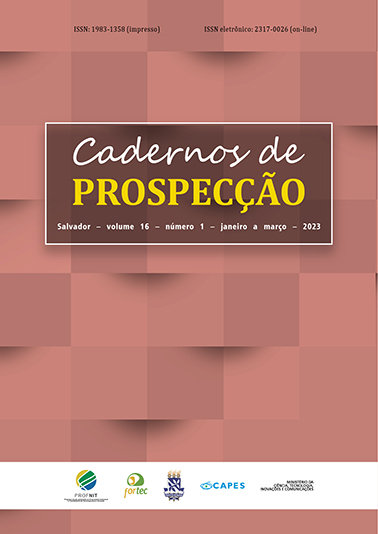Current Scenario of Patentary Protection for Fish Processing Technologies in Brazil
DOI:
https://doi.org/10.9771/cp.v16i1.46971Keywords:
Fish Processing, Technology, Patents.Abstract
With the growth of the world population, the fish processing sector will play an increasingly important role in food production, driving the need to seek new technologies. This work aims to carry out a survey of the current scenario of patent protection of fish processing technologies in Brazil and in the world through a technological prospection in the patent bases of the National Institute of Industrial Property and Google Patents, using for this a set of codes indexed in the International Patent Classification related to the technological branch of fish processing. The results show that individuals and universities are the largest applicants for patent applications in Brazil, showing that the national industry is not very innovative. In addition, approximately 90,000 patent documents deposited around the world were identified and are available for free adoption by Brazilian companies.
Downloads
References
BRASIL. Lei n. 10.973, de 2 de dezembro de 2004. Dispõe sobre incentivos à inovação e à pesquisa científica e tecnológica no ambiente produtivo e dá outras providências. Brasília: DF: Presidência da República, 1996. Disponível em: http://www.planalto.gov.br/ccivil_03/_ato2004-2006/2004/lei/l10.973.htm. Acesso em: 28 set. 2021.
BRASIL. Lei n. 9.279, de 14 de maio de 1996. Regula direitos e obrigações relativos à propriedade industrial. Brasília: DF: Presidência da República, 1996. Disponível em: http://www.planalto.gov.br/ccivil_03/leis/l9279.htm. Acesso em: 28 set. 2021.
CUP – CONVENÇÃO DE PARIS PARA A PROTEÇÃO DA PROPRIEDADE INDUSTRIAL. Convenção da União de Paris. Estocolmo, 1967. Disponível em: http://www.planalto.gov.br/ccivil_03/decreto/1990-1994/anexo/and1263-94.pdf. Acesso em: 25 ago. 2021.
FAO – ORGANIZAÇÃO DAS NAÇÕES UNIDAS PARA A ALIMENTAÇÃO E AGRICULTURA. El estado mundial de la pesca y la acuicultura 2020 – La sostenibilidad en acción. Roma: FAO, 2020. Disponível em: http://www.fao.org/3/ca9229es/ca9229es.pdf. Acesso em: 14 abr. 2021.
FERNANDES, A. M. A inovação e a apropriação do conhecimento na aqüicultura brasileira. 2013. 176f. Dissertação (Mestrado) – Curso de Mestrado Profissional em Propriedade Intelectual e Inovação, Academia de Propriedade Intelectual, Inovação e Desenvolvimento, Coordenação de Programas de Pós-Graduação e Pesquisa, Instituto Nacional de Propriedade Industrial, Rio de Janeiro, 2013. Disponível em: https://www.gov.br/inpi/pt-br/servicos/academia/arquivo/arquivos-biblioteca/FERREIRAAnaMaria2013.pdf. Acesso em: 14 abr. 2021.
FERREIRA, A. A.; GUIMARÃES, E. R.; CONTADOR, J. C. Patente como instrumento competitivo e como fonte de informação tecnológica. Gestão & Produção, [s.l.], v. 16, n. 2, p. 209-221, 2009.
INPI – INSTITUTO NACIONAL DA PROPRIEDADE INDUSTRIAL. Rankings dos Depositantes Residentes em 2019. Rio de Janeiro: INPI, 2019. Disponível em: https://www.gov.br/inpi/pt-br/acesso-a-informacao/pasta-x/estatisticas-preliminares/arquivos/documentos/ranking-maiores-depositantes-residentes-2019.pdf. Acesso em: 30 ago. 2021.
INPI – INSTITUTO NACIONAL DA PROPRIEDADE INDUSTRIAL. Patentes: perguntas frequentes. 2020a. Disponível em: https://www.gov.br/inpi/pt-br/servicos/perguntas-frequentes/patentes#patente. Acesso em: 28 set. 2021.
INPI – INSTITUTO NACIONAL DA PROPRIEDADE INDUSTRIAL. Indicadores de Propriedade Industrial 2020: o uso do sistema de propriedade industrial no Brasil. Rio de Janeiro: INPI, 2020b. p. 50. Disponível em: https://www.gov.br/inpi/pt-br/acesso-a-informacao/pasta-x/boletim-mensal/arquivos/documentos/indicadores-2020_aecon_vf-27-01-2021.pdf. Acesso em: 28 ago. 2021.
INPI – INSTITUTO NACIONAL DA PROPRIEDADE INDUSTRIAL. Patente: da importância e sua proteção. Rio de Janeiro: INPI, 2021. 28p. Disponível em: https://www.gov.br/inpi/pt-br/composicao/arquivos/CartilhaINPI_Patente_Daimportnciasuaproteo.pdf. Acesso em: 28 set. 2021.
OMPI – ORGANIZAÇÃO MUNDIAL DA PROPRIEDADE INTELECTUAL. Patents. 2019. Disponível em: https://www.wipo.int/edocs/pubdocs/en/wipo_pub_941_2019-chapter1.pdf. Acesso em: 15 abr. 2021.
ONU – ORGANIZAÇÃO DAS NAÇÕES UNIDAS. World Population Prospects 2019: Highlights. 2019. Disponível em: https://population.un.org/wpp/Publications/Files/WPP2019_10KeyFindings.pdf. Acesso em: 14 abr. 2021.
POLACHECK, T. Tuna longline catch rates in the Indian Ocean: Did industrial fishing result in a 90% rapid decline in the abundance of large predatory species? Marine Policy, [s.l.], v. 30, n. 5, p. 470-482, 2006.
RIBEIRO, N. M. (org.). Prospecção tecnológica. Salvador: IFBA, 2018. v. 1. 194 p.
ROJO, I.; ANADÓN, J. D.; GARCÍA-CHARTON, J. A. Exceptionally high but still growing predatory reef fish biomass after 23 years of protection in a Marine Protected Area. PLoS ONE, [s.l.], v. 16, n. 2, p. e0246335, 2021.
ROSSETTO, J. F.; SIGNOR, A. Inovações tecnológicas empregadas em coprodutos gerados pelo processamento do pescado. PUBVET, [s.l.], v. 15, n. 4, p. 1-11, 2021.
RUIZ-SALMÓN, I. et al. Life cycle assessment of fish and seafood processed products–a review of methodologies and new challenges. Science of the Total Environment, [s.l.], v. 761, p. 144094, 2020.
SAATH, K. C. O.; FACHINELLO, A. L. Crescimento da demanda mundial de alimentos e restrições do fator terra no Brasil. Revista de Economia e Sociologia Rural, [s.l.], v. 56, n. 2, p. 195-212, 2018.
VIDAL, M. F.; XIMENES, L. F. Produção de pescados na área de atuação do BNB. Fortaleza: Banco do Nordeste do Brasil, ano 4, n. 91, 2019.
Downloads
Published
How to Cite
Issue
Section
License
Copyright (c) 2022 Cadernos de Prospecção

This work is licensed under a Creative Commons Attribution-NonCommercial 4.0 International License.
O autor declara que: - Todos os autores foram nomeados. - Está submetendo o manuscrito com o consentimento dos outros autores. - Caso o trabalho submetido tiver sido contratado por algum empregador, tem o consentimento do referido empregador. - Os autores estão cientes de que é condição de publicação que os manuscritos submetidos a esta revista não tenham sido publicados anteriormente e não sejam submetidos ou publicados simultaneamente em outro periódico sem prévia autorização do Conselho Editorial. - Os autores concordam que o seu artigo ou parte dele possa ser distribuído e/ou reproduzido por qualquer forma, incluindo traduções, desde que sejam citados de modo completo esta revista e os autores do manuscrito. - Revista Cadernos de Prospecção está licenciado com uma Licença Creative Commons Attribution 4.0. Esta licença permite que outros remixem, adaptem e criem a partir do seu trabalho para fins não comerciais, e embora os novos trabalhos tenham de lhe atribuir o devido crédito e não possam ser usados para fins comerciais, os usuários não têm de licenciar esses trabalhos derivados sob os mesmos termos.
Este obra está licenciado com uma Licença Creative Commons Atribuição 4.0 Internacional.





